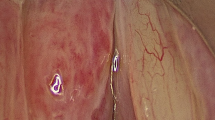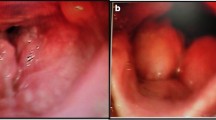Abstract
The diagnostic and treatment of verrucous lesions of the larynx involves a high level of suspicion by the physician attending the patient. The causes may go from unspecific laryngitis to neoplasia and granulomatous diseases. This kind of lesion is uncommon and the presentation aspects may vary broadly. The lesions in larynx are significant source of morbidity. The onset of symptoms is insidious and the diagnosis is usually delayed. Symptoms include dysphonia, dyspnea, dysphagia and odynophagia. Proper treatment depends upon tissue biopsy, identification of the causative organism, and the appropriate pharmacotherapy. As there are few papers presenting the clinical features of infectious granulomatous laryngitis (IGL) as leishmaniasis, tuberculosis and paracoccidiodomycosis affecting the larynx, we considered important to show the experience of a big Brazilian Laryngology Service in dealing with this potential worldwide problem. We present a retrospective chart review showing our institution’s experience with IGL focusing in the diagnostic, treatment and prognosis aspects. Twenty-four patients were identified. Mycobacterium tuberculosis and Paracoccidiodis brasiliensis accounted for ten cases each, and Leishmania braziliensis the remaining four. Hoarseness was the most common symptom of infection. Up to one-third of patients with laryngeal involvement lacked laryngeal symptoms. The average delay from onset of symptoms to diagnosis was 7 months. All patients underwent direct laryngoscopy and biopsies. Caseating granulomas was the key histopathologic finding. Identification of the causative organism was uncommon. No evidence of concomitant malignancy was seen on biopsy. Despite treatment, almost 40% of patients had permanent sequelae of infection, including hoarseness, dyspnea, and dysphagia. Mycobacterium tuberculosis, P. brasiliensis, and L. braziliensis accounted for all cases of IGL. Patients may have laryngeal infection but lack laryngeal symptoms. Prompt diagnosis relies upon a high index of suspicion, especially when evaluating patients from endemic areas. Given the degree of tissue destruction, which accompanies infection, timely intervention may be important in the prevention of late sequelae. Despite appropriate therapy, a significant number of patients may have permanent sequelae of infection.



Similar content being viewed by others
References
Wang CC, Lin CC, Wang CP, Liu SA, Jiang RS (2007) Laryngeal tuberculosis: a review of 26 cases. Otolaryngol Head Neck Surg 137(4):582–588
Prasad KC, Sreedharan S, Chakravarthy Y, Prasad SC (2007) Tuberculosis in the head and neck: experience in India. J Laryngol Otol 121(10):979–985
Rizzo PB, Da Mosto MC, Clari M, Scotton PG, Vaglia A, Marchiori C (2003) Laryngeal tuberculosis: an often forgotten diagnosis. Int J Infect Dis 7(2):129–131
Thompson St. C (1924) Tuberculosis of larynx: its significance to physician. Lancet 2:948–949
Silva L, Klautau GB, Costa HOO (2002) Laringites Específicas. In: Otacílio & Campos Tratado de Otorrinolaringologia, vol 4 (ed1), São Paulo, Roca, pp 393–415
Lim JY, Kim KM, Choi EC, Kim YH, Kim HS, Choi HS (2006) Current clinical propensity of laryngeal tuberculosis: review of 60 cases. Eur Arch Otorhinolaryngol 263(9):838–842
Manns BJ, Baylis BW, Urbansky SJ et al (1996) Paracoccidioidomycosis: case report and review. Clin Infect Dis 23:1026–1032
Marques AS (1998) Paracoccidioidomicose. An Bras Dermatol 73(2):455–469
Morales Puebla JM, Padilla Parrado M, Díaz Sastre MA, Chacón Martinez J, Galán Morales JT, Lasso Luis MO, Jiménez Antolin JA, Menéndez Loras LM (2006) Laryngeal tuberculosis. Incidence between 1994 and 2004. An Otorrinolaringol Ibero Am 33(6):591–598
Menon K, Bem C, Gouldesbrough D, Strachan DR (2007) A clinical review of 128 cases of head and neck tuberculosis presenting over a 10-year period in Bradford, UK. J Laryngol Otol 121(4):362–368
Krecicki T, Zalesska-Krecicka M, Zatonski T, Jankowska R, Skrzydlewska-Kaczmarek B (2004) Laryngeal tuberculosis. Lancet Infect Dis 4(1):57
Motta AC, Lopes MA, Ito FA, Carlos-Bregni R, de Almeida OP, Roselino AM (2007) Oral leishmaniasis: a clinicopathological study of 11 cases. Oral Dis 13(3):335–340
Couldery AD (1990) Tuberculosis of the upper respiratory tract misdiagnosed as Wegener’s granulomatosis––an important distinction. J Laryngol Otol 104:255–258
Flanagan PM, McIlwain JC (1993) Tuberculosis of the larynx in a lepromatous patient. J Laryngol Otol 107:845–847
Thaller SR, Gross JR, Pilch BZ (1987) Laryngeal tuberculosis as manifested in the decades 1963–83. Laryngoscope 97(7 Pt1):848–850
Swallow CE, McAdams HP, Colon E (1984) Tuberculosis manifested by a laryngeal mass on CT scans. AJR (1994) 163:179–180. Laryngoscope 94:608–611
Cantarella G, Pagani D, Fasano V, Scaramellini G (2007) Glottic tuberculosis masquerading as early multifocal carcinoma. Tumori 93(3):302–304
Sant’Anna GD, Mauri M, Arrarte JL, Camargo H Jr. (1999) Laryngeal manifestations of paracoccidioidomycosis (South American blastomycosis). Arch Otolaryngol Head Neck Surg 125(12):1375–1378
Tristano AG, Díaz L (2007) A case of laryngeal paracoccidioidomycosis masquerading as chronic obstructive lung disease. South Med J 100(7):709–711
Payne J, Koopmann CF (1984) Laryngeal carcinoma or is it laryngeal blastomycosis? Laryngoscope 94(5 Pt1):608–611
Bailey CM, Windle-Taylor PC (1981) Tuberculous laryngitis: a series of 37 patients. Laryngoscope 91:93–100
Ibarra A, Arellano L (1983) Tuberculosis laringea: experiencia en 16 casos. Rev Med Chil 111:39–42
Maymo Arganaraz M, Luque AG, Tosello ME et al (2003) Paracoccidioidomycosis and larynx carcinoma. Mycoses 46:229–232
Londero AT (1982) Paracoccidioidomicose. In: Del Negro G, Lacaz CS, Fiorillo AM (eds) São Paulo, Sarvier, pp 85–90
Reder PA, Neel HB 3rd (1993) Blastomycosis in otolaryngology: review of a large series. Laryngoscope 103(1 Pt 1):53–58
Ebeo CT, Olive K, Byrd RP Jr, Mirle G, Roy TM, Mehta JB (2002) Blastomycosis of the vocal folds with life-threatening upper airway obstruction: a case report. Ear Nose Throat J 81(12):852–855
Ulloa R, Avila ML, Soto M et al (1998) Laryngeal tuberculosis. Pediatr Infect Dis J 17:758–760
Ramadan HH, Wax MK (1995) Laryngeal tuberculosis. A cause of stridor in children. Arch Otolaryngol Head Neck Surg 121: 109–112
Castro CC, Benard G, Ygaki Y et al (1999) MRI of head and neck paracoccidioidomycosis. Br J Radiol 72: 717–722
Sarazin F, Sainte-Marie D, Demar M, Aznar C, Sarrouy J, Pradinaud R, Carme B, Couppié P (2005) Cutaneous-mucosal paracoccidio-domycosis: the first case diagnosed in French Guiana. Ann Dermatol Venereol 132(2):136–139
Negroni R (1993) Paracoccidioidomycosis. Int J Dermatol 32:847–859
Franco MF, Mendes RP, Moscardi-Bacchi TV et al (1989) Paracoccidioidomycosis. Clin Trop Med Commun Dis 4:185–220
Mendes RP (1994) The gamut of clinical manifestations. In: Granco M, Lacaz CS, Restrepo-Moreno A, Del Negro G (eds) Paracoccidioidomycosis. CRC, Boca Raton, pp 233–258
Grimaldi G, Tesh RB, McMahon-Pratt D (1989) A review of the geographic distribution and epidemiology of leishmaniasis in the new world. Am J Trop Med Hyg 41:687–725
Martins R, Marques SA, Alves M, Fecchio D et al. (1997) Serological follow-up of patients with paracoccidioidomycosis treated with itraconazole using dot-blot and Western-blot. Rev Inst Med Trop São Paulo 39:261–269
Passos VMA, Falcao AL, Marzochi MCA (1993) Epidemiological aspects of American cutaneous leishmaniasis in a periurban area of the metropolitan region of Belo Horizonte, Minas Gerais, Brazil. Mem Inst Oswaldo Cruz 88:103–110
Díaz Sastre MA, Padilla Parrado M, Morales Puebla JM, Jiménez Antolín JA, Caro García MA, Chacón Martínez J, Menéndez Loras LM, Orradre Romeo JL (2007) Laryngeal leishmaniasis. An Otorrinolaringol Ibero Am 34(1):17–25
Author information
Authors and Affiliations
Corresponding author
Rights and permissions
About this article
Cite this article
Silva, L., Damrose, E., Bairão, F. et al. Infectious granulomatous laryngitis: a retrospective study of 24 cases. Eur Arch Otorhinolaryngol 265, 675–680 (2008). https://doi.org/10.1007/s00405-007-0533-4
Received:
Accepted:
Published:
Issue Date:
DOI: https://doi.org/10.1007/s00405-007-0533-4




